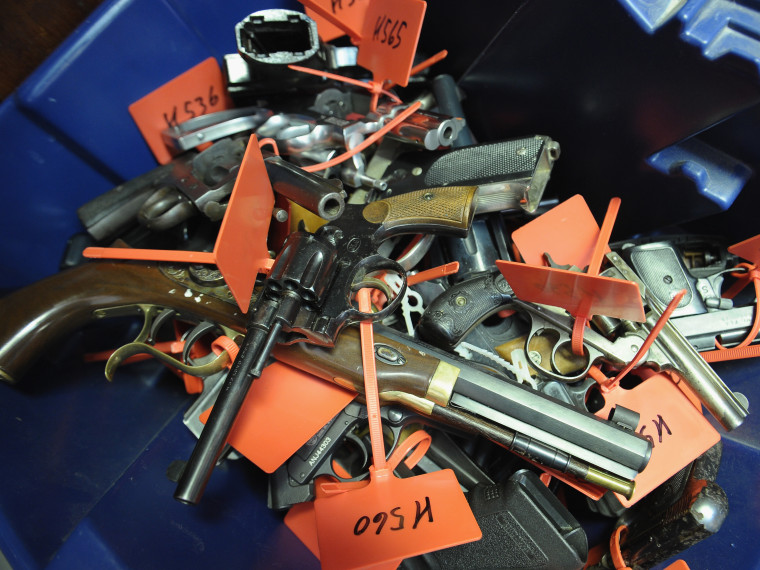On Sunday in New Orleans, Laderika Smith, 28, returned from the store to find her five-year-old daughter bloodied and lying on the bedroom floor with a gunshot wound to her head. The girl soon died. Her mother has been charged with Relative Cruelty to a Juvenile. She has not yet entered a plea.
“It is all too common,” Doctor Gary A. Smith, president of the Child Injury Prevention Alliance, told msnbc. “Children are curious. They watch TV cartoons and a make-believe world,” he added. When kids see guns, “they don’t recognize the danger.”
Smith’s daughter fatally shot herself with a .38 revolver that her mother kept in the home, as Smith admitted to New Orleans police. For decades, a .38 revolver was the firearm most commonly used in crimes, according to ATF studies including a July 2000 report, which is the last time that the ATF issued any comprehensive report. Instead, for more than 12 years-- since the first inauguration of President George W. Bush in 2001--the ATF has provided little or no such national data to the public.
“Why was it stopped for over 10 years?” ATF Acting Deputy Chief of Public Affairs Donna Sellers told msnbc. “I cannot really answer why a decision was made to stop publishing that information,” she added. “The decision was made this year to increase transparency and provide the public with more thorough information on crime guns.”
On June 19, the ATF published its findings for Firearms Trace Data for 2012. Data for previous years posted on the ATF website’s statistics page include no more than very general information for each state along with the District of Columbia and U.S. Virgin Islands, making in difficult to discern national trends of the types of firearms used in crimes, or where they were bought.
The data for 2012 includes nationally aggregated summaries including “Firearms Types” and “Top Calibers” of weapons “Recovered and Traced” in crimes, along with data on where the weapons used in crimes were purchased and where they ended up, and how long they have been in circulation.
“Tracing crime guns provides critical information that assists domestic and international law enforcement,” Sellers told msnbc.
Most “crime guns,” as ATF officials call them, end up in circulation for just over 11 years. Another trend that emerges from the data is that a .38 caliber handgun has become only the fifth most common caliber of firearm used in crimes (19,425) in 2012, after the 9 millimeter (42,560) of roughly the same size, the smaller .22 caliber handgun (34,130) long ago dubbed as a “Saturday night special,” and the far more powerful .40 caliber handgun (20,674), and the 12-gauge shotgun (20,606), according to ATF statistics now available online.
The ATF’s change to release firearms tracing information is consistent with White House policies since the Newtown tragedy. In January, President Obama signed a 23-point gun control order involving various U.S. agencies to expand their reporting and other activities involving firearms and violence.
Another new trend is that pistols were the most common type of weapon used in crimes in 2012, consistent with the rising use of 9 millimeter handguns in crimes (the overwhelming majority of which are pistols), and the increasingly commercial popularity of 9 millimeter pistols like Austrian-made Glock. U.S. authorities seized a total of 119,273 pistols and 46,037 revolvers from crime scenes in 2012, according to ATF figures published last week.
The common reason given by authorities for seizing firearms from suspects was for illegal possession of a weapon at 61,501 cases, the ATF statistics show. A total of 17,239 firearms were seized for an offense involving a weapon. The average age of the suspect from which a firearm was seized was lowest in the two U.S. territories of the U.S. Virgin Islands at 28, and the District of Columbia at 29, and highest in South Dakota at 45, and Hawaii at 47.
But the flow of firearms across state lines may be the most important statistic to emerge at a time when Congress is continuing to discuss the possibility of increased gun regulations including anti-trafficking legislation. Some states supplied a great many guns used in crimes across the nation. West Virginia was the source of 1,330 crime guns in 2012, nearly half of which were used in crimes in other states.
Other states supplied few guns but ended up being the place where many guns were used in crimes. New York supplied 2,153 guns used in crimes across the nation, and ended up having more than twice as many firearms, 4,850, recovered in crimes inside the state.
